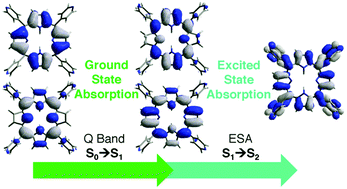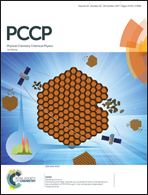Excited-state absorption in tetrapyridyl porphyrins: comparing real-time and quadratic-response time-dependent density functional theory†
Abstract
Three meso-substituted tetrapyridyl porphyrins (free base, Ni(II), and Cu(II)) were investigated for their optical limiting (OL) capabilities using real-time (RT-), linear-response (LR-), and quadratic-response (QR-) time-dependent density functional theory (TDDFT) methods. These species are experimentally known to display a prominent reverse saturable absorption feature between the Q and B bands of the ground-state absorption (GSA), which has been attributed to increased excited-state absorption (ESA) relative to GSA. A recently developed RT-TDDFT based method for calculating ESA from a LR-TDDFT density was utilized with eight exchange–correlation functionals (BLYP, PBE, B3LYP, CAM-B3LYP, PBE0, M06, BHLYP, and BHandH) and contrasted with calculations of ESA using QR-TDDFT with five exchange–correlation functionals (BLYP, B3LYP, CAM-B3LYP, BHLYP, and BHandH). This allowed for comparison between functionals with varying amounts of exact exchange as well as between the ability of RT-TDDFT and QR-TDDFT to reproduce OL behavior in porphyrin systems. The absorption peak positions and intensities for GSA and ESA are significantly impacted by the choice of DFT functional, with the most critical factor identified as the amount of exact exchange in the functional form. Calculating ESA with QR-TDDFT is found to be significantly more sensitive to the amount of exact exchange than GSA and ESA with RT-TDDFT, as well as GSA with LR-TDDFT. An analogous behavior is also demonstrated for the polycyclic aromatic hydrocarbon coronene. This is problematic when using the same approximate functional for calculation of both GSA and ESA, as the LR- and QR-TDDFT excitation energies will not have similar errors. Overall, the RT-TDDFT method with hybrid functionals reproduces the OL features for the porphyrin systems studied here and is a viable computational approach for efficient screening of molecular complexes for OL properties.



 Please wait while we load your content...
Please wait while we load your content...